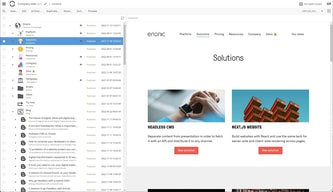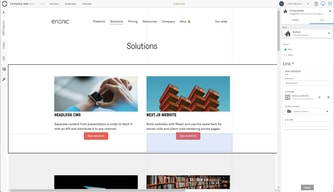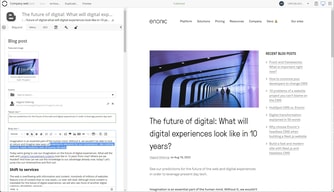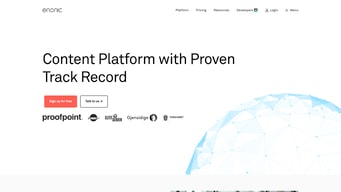

Unclaimed: Are are working at Enonic ?
Enonic Reviews & Product Details
Enonic is a leading digital experience platform that helps businesses create and manage their digital presence efficiently. It combines powerful tools for content management, commerce, and data management in one platform with core features that include an intuitive content editor, headless commerce, and robust data management capabilities. By using Enonic, businesses can streamline their digital operations, save time and resources, and create seamless and personalized digital experiences for their customers.

| Capabilities |
|
|---|---|
| Segment |
|
| Deployment | Cloud / SaaS / Web-Based, On-Premise Linux, On-Premise Windows |
| Support | 24/7 (Live rep), Chat, Email/Help Desk, FAQs/Forum, Knowledge Base, Phone Support |
| Training | Documentation |
| Languages | English |






Compare Enonic with other popular tools in the same category.

My favourite part of Enonic XP is the flexibility the platform provides and the helpful community on discuss.enonic.com and their Slack community. Enonic XP can be used for both small, medium and large websites, in both a traditional monilithic way and pure headless, or even a hybrid. This makes the platform perfect for us, at it allows ut to build user-focused experiences without being forced by the platform to do things in a particular way. Our developers love being able to choose wether to code in pure JavaScript or TypeScript or even use frameworks such as Vue or React. The content editors also enjoy the freedom and flexibility of Content Studio, allowing them to either use templates when building content, or engaging their creativity and make a completely different page optimized for a particular use-case.
The documentation could be better and include more complex examples. It would also be nice if there were more apps on market.enonic.com. Even though Elasticsearch is great, the version bundled with Enonic is not the newest, and we would love to have more access to the index.
We use Enonic XP hosted in Enonic Cloud to help our customers serve their users and customers great online experiences. Ranging from corporate information sites, through webshops to intranets, Enonic XP can do it all.
I like the user interface, it is easy to learn and easy to use for me as a web editor.
I'm not sure if I have any specific down sides, but sometimes it can take a while for Enonic to develop features we ask for thru our partner. But they listen and take our suggestions into account.
We use Enonic XP as our CMS and are very satisfied with the product. Our partner Bouvet handles everything so we don't really contact Enonic that often, but we do attend some webinars and have yearly meetings.
I was first introduced to Enonic XP7 when I was still attending Uni. The solution was easy to get into, as the stack uses languages and technology most are already familiar with. Now, after having used XP for some years, I am still satisfied, and the product keeps on getting better. There's always something new and exciting getting released for their product, and I can't wait what the future of this product will be. The staff at Enonic are easy to get in touch with, either on their forum or their Slack, and the community helps each other out with issues and problem solving. I have briefly used similar CMS solutions, like Optimizely (formerly Episerver). They ship out a robust product, which is too grand from the start. XP on the other hand, takes less than a day to learn and begin developing in, without any unnecessary overhang.
As with everything, XP is not perfect. The company and product have existed for years, yet some areas it's not as polished as one would expect it to be. I do miss having more restrictions on parts - how many are allowed on a page, or in which area you're allowed to place some, but not others. Also, there's a lack of configurability for the WYSIWYG-editor. I have found areas where I'd love to add custom fonts or styling to text, yet not being able to add new, just alter the existing ones. One solution of course would be inserting macros, but that's not the perfect solution to possibly inexperienced editors.
XP's tasks have helped me out a lot in a project, where it's scheduled to run daily and retrieve data from an external source. After having done so, it generates content based off of the data, and doesn't overwrite existing, yet updating the changes flawlessly.
An editor-friendly editor, quick access to all content on site with elastic search, flexible solution.
It annoys me a LOT that the browser spellcheck still does not work in titles.
We use Enonic as the publishing platform for an online news site with ads.
Lots of possibilities. Dynamic. Good user interface
We experience sometimes that errors appear, and that it can be hard to see where to adress it - whether it is Enonic or the developer.
We have more control over the content and what to put on the index page e.g. It's more flexible and gives us more possibilities.
The layer structure fits our international company structure well and fuels collaboration between content departments. On the developer side I find that we have solutions to almost all of our wants and needs and it's well integrated with our visual profile. I like the overall flexibility; from working with tags for our content, tasks between content editors, the site and search function are super fast, moving and sharing content. As a content editor the platform works great.
The layer structure makes all the pages from the parent page visible on the "child" pages. I know that they're working on a fix for this in a release coming soon. I also miss Digital Assets Management, even though our developers have developed a similar function through the layer function which works almost just as well.
Our SEO work and ranking have significantly improved after we migrated to Enonic XP. The benefits with the layer function have been several as our communication team across countries collaborate closely and Enonic XP is just the right tool for us to share and collaborate on content and structure.
The total control you have of the metadata for your project. The structures give reusable data/fragments that are easy to implement for both developer and maintainer.
It would be best if you were a skilled javascript developer to start maintaining a project. It requires more of you as a developer, and it can be confusing that the server-side javascript doesn't support npm packages.
We are making a homepage for a political party. The reuse of fragments and data is the most significant benefit of Enonic. Accessible tools and wizards to start a new project.
It´s easy to get the hang of Enonic XP. As a content editor, you get a sense of endless possibilities. You can use templates or build pages by drag-and-drop. Together with a good developer, you can make almost anything. In addition, there are several useful apps on Enonic market. We use Enonic XP for our relatively small web platform and look forward to scaling up in the future. I like: - Issues management - Image handling - Version comparison Also, the team at Enonic is fast to respond, polite, and always very thorough. You get in contact with them and the rest of the community through Slack and the user forum.
- Some of the apps on Enonic market is quite simple.
We have recently moved our web platform into Enonic XP. Benefits: - Building pages is fast - Low-level content creators can use the site with ease - Up-to-date technology (headless) gives us many possibilities
I've been using Enonic for close to a year now. From what I've experienced, I've seen a lot of capabilities. Everything that I needed to implement I have found a clean way to do, and when not natively, you can implement a Java extension to do what is required. It's an excellent and versatile development experience. One really nice thing is that the support through Discuss forum and Slack works very well, and you talk directly to the skilled and friendly people who are developing the features. The last thing that is worth mentioning is that the learning curve is not high. The idea of development is a bit unique, but once you understand it through the documentation, you can become productive with Enonic relatively fast.
- The docummentation is well written, but IMHO I believe that there is space to improve it with more examples; - The community is not huge since It's not a wide known technology yet; - There isn't a lot of apps in the Enonic market;
In the last company that I worked on, the team was using Enonic as the primary platform for development, building complex web apps using server-side javascript (or typescript). There's also room to do many cool things using modern front-end frameworks such as Vue and React, for example.
Enonic is versatile, robust and user-friendly. I love the hybrid approach, combining both headless and traditional editorial functionality. We use it for multiple sites at Gjensidige, and have successfully integrated it with our design system.
I would have liked an even bigger community, so please consider trying it out.
We use it as a key part of our web platform for both internal and customer-facing digital services in four different countries. Works great on-prem and in the cloud, and both for developers, digital editors and content designers.